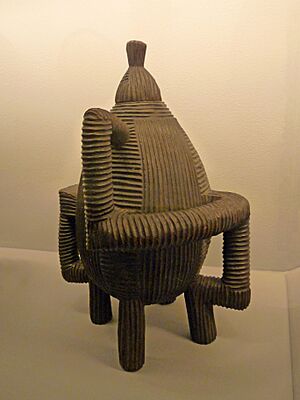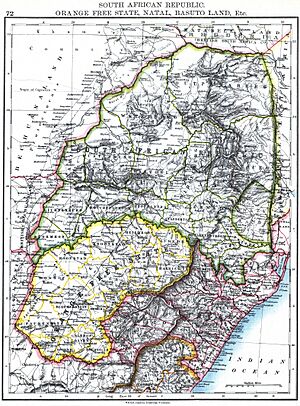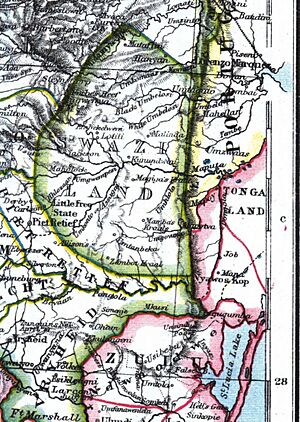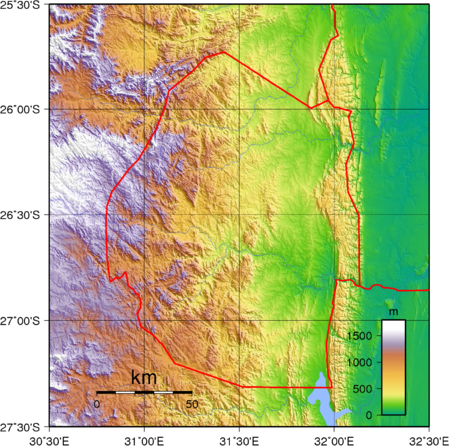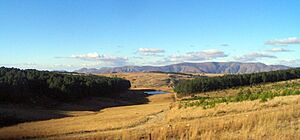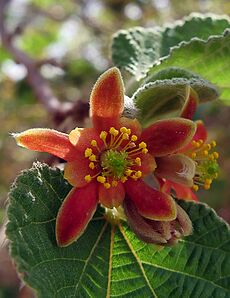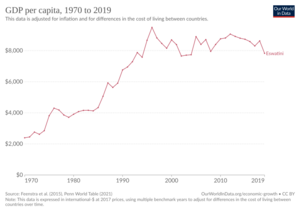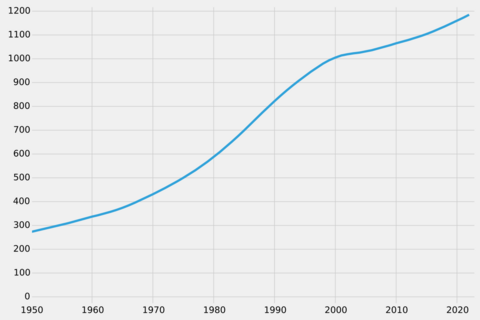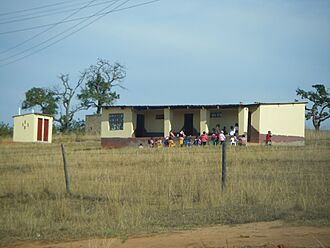Eswatini facts for kids
Quick facts for kids
Kingdom of Eswatini
Umbuso weSwatini (Swazi)
|
|
|---|---|
|
|
|
|
Motto:
"Siyinqaba" (Swazi) "We are a fortress" "We are a mystery" "We hide ourselves away" "We are powerful ones" |
|
|
Anthem:
"Nkulunkulu Mnikati wetibusiso temaSwati" "Oh God, Giver of Blessings to the Swazi" |
|

Location of Eswatini (red)
|
|
| Capital |
26°30′S 31°30′E / 26.500°S 31.500°E |
| Largest city | Mbabane |
| Official languages | |
| Ethnic groups
(2017)
|
|
| Religion
(2017)
|
|
| Demonym(s) | Swazi |
| Government | Unitary absolute monarchy |
|
• King
|
Mswati III |
| Ntfombi | |
| Russell Dlamini | |
| Legislature | Parliament |
| Senate | |
| House of Assembly | |
| Independence from the United Kingdom | |
|
• Independence granted
|
6 September 1968 |
|
• United Nations membership
|
24 September 1968 |
|
• Current constitution
|
2005 |
|
• Renaming
|
19 April 2018 |
| Area | |
|
• Total
|
17,364 km2 (6,704 sq mi) (153rd) |
|
• Water (%)
|
0.9 |
| Population | |
|
• 2023 estimate
|
1,236,126 (155th) |
|
• 2017 census
|
1,093,238 |
|
• Density
|
66.8/km2 (173.0/sq mi) (135th) |
| GDP (PPP) | 2023 estimate |
|
• Total
|
|
|
• Per capita
|
|
| GDP (nominal) | 2023 estimate |
|
• Total
|
|
|
• Per capita
|
|
| Gini (2016) | ▲ 54.6 high |
| HDI (2022) | medium · 142nd |
| Currency |
|
| Time zone | UTC+2 (SAST) |
| Driving side | left |
| Calling code | +268 |
| ISO 3166 code | SZ |
| Internet TLD | .sz |
Eswatini (ESS-wah-TEE-nee), officially the Kingdom of Eswatini, used to be called Swaziland. It is a country in Southern Africa that is surrounded by land. Mozambique is to its northeast, and South Africa borders it on all other sides. Eswatini is one of Africa's smallest countries. It is about 200 km (120 mi) from north to south and 130 km (81 mi) from east to west. Even though it's small, it has many different climates and landscapes. These range from cool, mountainous areas to hot, dry lowlands.
Most of the people in Eswatini are Swazi. The main language spoken is Swazi, also called siSwati. The Swazi people created their kingdom in the mid-1700s, led by Ngwane III. The country and its people are named after Mswati II. He was a king in the 1800s who made the country bigger and united it. Its borders were set in 1881 during a time when European countries were claiming parts of Africa. After the Second Boer War, the kingdom was under British rule from 1903. It became fully independent on September 6, 1968. In April 2018, the country's official name changed from Kingdom of Swaziland to Kingdom of Eswatini. This new name is what the Swazi people commonly use.
Eswatini is a developing country with a lower-middle income economy. It is part of the Southern African Customs Union and the Common Market for Eastern and Southern Africa. Its main trading partner is South Africa. To keep its economy stable, Eswatini's money, the lilangeni, is linked to the South African rand. The United States and the European Union are Eswatini's main trading partners outside of Africa. Most jobs in the country are in farming and manufacturing. Eswatini is also a member of the Southern African Development Community, the African Union, the Commonwealth of Nations, and the United Nations.
The government is an absolute monarchy, which means the king has all the power. King Mswati III has ruled since 1986. Elections happen every five years to choose members for the House of Assembly and the Senate. However, political parties are not allowed to take part in these elections. The country's constitution was put in place in 2005. Two very important national events are Umhlanga, the reed dance, and incwala, the kingship dance. These events celebrate Swazi culture and traditions. The Swazi people face major health challenges, including HIV/AIDS.
Contents
History of Eswatini
People have lived in the area of Eswatini for a very long time. Tools and other items show human activity from about 200,000 years ago. You can also find ancient rock art paintings around the country. Some of these paintings are as old as 27,000 years.
The first people known to live here were Khoisan hunter-gatherers. Later, the Nguni people arrived during the Bantu migrations. These groups came from the Great Lakes region in eastern and central Africa. We know that farming and iron use started around the 4th century. People who spoke languages similar to today's Sotho and Nguni languages began settling here by the 11th century.
Swazi Settlers (18th and 19th Centuries)
The Swazi settlers were first known as the Ngwane. They lived near the Pongola River before moving into Eswatini. Before that, they were near the Tembe River in what is now Mozambique. Conflicts with the Ndwandwe people made them move further north. Ngwane III then set up his capital at Shiselweni.
Under Sobhuza I, the Ngwane people moved their capital to Zombodze. This is in the heart of today's Eswatini. They took over and joined with older clans in the country. These clans were known as Emakhandzambili, meaning "those found ahead".
Eswatini got its name from a later king, Mswati II. KaNgwane, named after Ngwane III, is another name for Eswatini. The royal family's name is still Nkhosi Dlamini. Mswati II was a very strong king. He made the country's area twice as big as it is now. The Emakhandzambili clans first joined the kingdom with a lot of freedom. But Mswati greatly reduced their power in the 1850s. He brought more people into his kingdom, either by conquering them or by offering them safety. These new arrivals were called Emafikamuva.
The Swazi nation's independence was affected by British and Dutch rule in southern Africa. In 1881, the British government agreed to recognize Swazi independence. This was even though many European countries were trying to take over parts of Africa. This independence was also confirmed in the London Convention of 1884.
King Mbandzeni allowed many Europeans to use Swazi land. This created a complicated system of land ownership. In 1890, after Mbandzeni died, a special court was set up. It was called the Swaziland Convention. This court helped settle arguments about land and other agreements.
In 1890, Swaziland was managed by three groups: the British, the Dutch, and the Swazi people. In 1894, Swaziland became a protectorate under the South African Republic. This continued until the Second Boer War started in October 1899.
King Ngwane V died in December 1899, during the incwala ceremony. His son, Sobhuza II, was only four months old. Swaziland was involved in the war with small fights between the British and the Boers until 1902.
British Rule (1906–1968)
In 1903, after the British won the Second Boer War, Swaziland became a British "High Commission Territory." The British did not fully take over, and the Swazi people managed their own areas.
A plan in 1904 looked at all the land agreements. By 1910, about 38% of Swaziland's land was set aside for the Swazi people. The queen regent then encouraged Swazis to work in the Transvaal. This was so they could earn money to buy more land from Europeans.
Much of the early government services were run from South Africa. This changed in 1906. Sobhuza's official crowning as king was in December 1921. He tried to get more land back for the Swazi people, but he was not successful.
From 1923 to 1963, Sobhuza II worked to strengthen the Swazi nation. He helped start businesses and schools for Swazi people. He also successfully stopped the British from taking more power. He prevented Swaziland from becoming part of the Union of South Africa.
In 1963, Britain created a new government plan for Swaziland. This plan set up a Legislative Council and an Executive Council. The king's Swazi National Council did not agree with this. But elections still happened, and the first Legislative Council started on September 9, 1964. By 1964, the land set aside for Swazis had grown to 56%. A new constitution was created in 1967, and elections were held. After these elections, Swaziland was a protected state until it became independent in 1968.
Independence (1968–Present)
After elections in 1972, King Sobhuza II stopped the constitution. He then ruled the country by himself until he died in 1982. Sobhuza II had been king for almost 83 years, making him one of the longest-reigning monarchs in history. After his death, his mother, Queen Regent Dzeliwe Shongwe, was head of state. She was later replaced by Queen Mother Ntfombi Tfwala in 1984. Mswati III, Ntfombi's son, became king in 1986.
In the 1990s, students and workers protested. They asked the king to make changes to the government. This led to new constitutional reforms, and the current Swazi constitution was put in place in 2005. The first election under this new constitution happened in 2008.
In 2011, Eswatini faced money problems. This was because of less income from the Southern African Customs Union. The government asked South Africa for a loan. However, they did not agree on the conditions for the loan, which included political changes.
During this time, there was more pressure on the Swazi government to make reforms. Protests by groups and trade unions became more common. By 2012, better income from the customs union helped the government's money situation. A new parliament was elected in 2013. The king then chose Sibusiso Dlamini as prime minister again.
On April 19, 2018, King Mswati III announced a name change. The Kingdom of Swaziland became the Kingdom of Eswatini. This change marked 50 years of Swazi independence. The name Eswatini means "land of the Swazis" in the Swazi language. It also helps avoid confusion with the country Switzerland.
Geography of Eswatini
Eswatini is a small country with no coastline. It covers an area of 17,364 km2 (6,704 sq mi). It is located at about 26°30'S, 31°30'E. South Africa borders it to the north, west, and south. Mozambique is to the east. Along the eastern border with Mozambique are the Lebombo Mountains. These mountains are about 600 metres (2,000 ft) high. Three rivers, the Ngwavuma, the Great Usutu, and the Mbuluzi, cut through these mountains. The western border is on the edge of a steep slope, about 1,200 metres (3,900 ft) high.
Eswatini has four main geographical areas. These areas run from north to south and are based on how high they are. Mbabane, the capital city, is in the Highveld. The Middleveld is about 700 metres (2,300 ft) above sea level. It is the most crowded part of Eswatini and gets less rain than the mountains. Manzini, the main business city, is in the Middleveld. The Lowveld is around 250 metres (820 ft) high. It has fewer people and looks like a typical African bush with thorn trees and grasslands.
Climate
Eswatini has four climate regions: the Highveld, Middleveld, Lowveld, and Lubombo plateau. Most rain falls during the summer months, from December to March. It often comes as thunderstorms. Winter is the dry season. The Highveld in the west gets the most rain, between 1,000 and 2,000 mm (39.4 and 78.7 in) each year. The further east you go, the less rain there is. The Lowveld gets 500 to 900 mm (19.7 to 35.4 in) per year.
Temperatures also change with how high the land is. The Highveld has mild temperatures and is rarely too hot. The Lowveld can reach about 40 °C (104 °F) in summer.
Average temperatures in Mbabane by season:
| Spring | September–October | 18 °C (64.4 °F) |
| Summer | November–March | 20 °C (68 °F) |
| Autumn | April–May | 17 °C (62.6 °F) |
| Winter | June–August | 13 °C (55.4 °F) |
The government of Eswatini is worried about climate change. It makes existing problems like poverty and food shortages worse. This could make it harder for the country to develop. For example, a drought in 2015–16 reduced sugar exports, which are very important to Eswatini's economy. Many of Eswatini's main exports are farm products, so they are easily affected by changes in climate.
Biodiversity and Conservation
Eswatini has many protected areas that help keep its rich variety of plants and animals safe. These areas cover about 5% of the country's land. Eswatini has over 820 types of animals with backbones and over 2400 types of plants. Many of these species are found only in Eswatini. This shows that Eswatini is very important for protecting biodiversity around the world.
The biggest threats to nature are land being damaged or changed for other uses. This includes planting crops, clearing bushes, and the spread of plants that are not native. Also, people sometimes use natural resources in ways that are not sustainable.
Eswatini is part of important international agreements. These include the Convention on Biological Diversity and the Convention on International Trade in Endangered Species (CITES). There are six official protected areas in the country. These include Malolotja Nature Reserve and Hlane Royal National Park. Many private and community nature reserves also exist.
From 2014 to 2021, Eswatini worked on a project to improve its protected areas. This project aimed to strengthen efforts to protect nature across the country.
Eswatini is home to 507 bird species. This includes 11 species that are globally threatened. There are also 107 mammal species native to Eswatini. This includes the critically endangered South-central black rhinoceros. Many different birds live here, like white-backed vultures and martial eagles.
Government and Politics
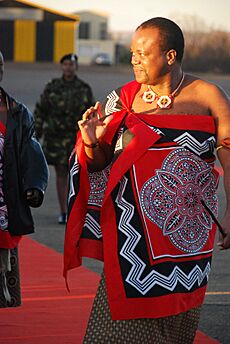
Monarchy
Eswatini is an absolute monarchy. This means the king has all the power, but there are also rules from the constitution and Swazi traditions. The head of state is the king, also called ngwenyama (which means 'lion'). The constitution says the king represents the unity and long life of the Swazi nation.
Traditionally, the king rules with his mother, who is called the ndlovukati (meaning 'she-elephant'). The king was seen as the leader of the government, and the queen mother was the spiritual leader. Her role was to balance the king's power. However, over time, the queen mother's role became more symbolic.
The king chooses the prime minister from the parliament. He also appoints most of the senators and some members of the lower house of parliament. He does this with help from an advisory council. The king can also appoint people to parliament to represent special groups. These could be people who were not elected, or those with disabilities, or important business people. This helps make sure different views are heard in parliament.
Parliament
Eswatini has a two-part parliament, called the Libandla. It has the Senate and the House of Assembly. The Senate has 30 members. Ten are chosen by the House of Assembly, and 20 are chosen by the king. They serve for five years. The House of Assembly has 65 members. Ten are chosen by the king, and 55 are elected by the people. They also serve for five years.
Elections happen every five years after the king dissolves parliament. The last elections were on September 29, 2023. These elections are non-partisan, meaning political parties do not officially take part. The Elections and Boundaries Commission oversees all election procedures.
Administrative Divisions
Eswatini is split into four main areas called regions. These are Hhohho, Lubombo, Manzini, and Shiselweni. Each region has smaller areas called tinkhundla (one is an inkhundla). A regional administrator manages each region. They get help from elected members in each inkhundla.
Local government is set up differently for rural and urban areas. Urban areas have city councils, town councils, or town boards. Rural areas have regional administration, tinkhundla, and chiefdoms. There are twelve urban areas and 55 tinkhundla. Each inkhundla has a development committee. This committee is elected from the different chiefdoms in its area. They bring local issues to the inkhundla and share decisions back with their chiefdoms.
The main cities and towns in Eswatini are Manzini, Mbabane, Nhlangano, and Siteki. These are also the capitals of their regions.
| Region # | Region | Capital | Area (km2) |
Population (2017 census) |
|---|---|---|---|---|
| 1 | Hhohho | Mbabane | 3,625.17 | 320,651 |
| 2 | Manzini | Manzini | 4,093.59 | 355,945 |
| 3 | Lubombo | Siteki | 5,849.11 | 212,531 |
| 4 | Shiselweni | Nhlangano | 3,786.71 | 204,111 |
Economy
Eswatini's economy is varied. Farming, forestry, and mining make up about 13% of the country's income. Manufacturing, especially textiles and sugar, makes up 37%. Services, with government services being the largest, make up 50%.
Most high-value crops like sugar and citrus are grown on privately owned lands. These areas have a lot of investment and irrigation, and they produce a lot. About 75% of the people work in subsistence agriculture on Swazi Nation Land. This means they grow just enough food for themselves. These farms produce less and have less investment.
Growing sugarcane, the country's biggest export, has involved some challenges for workers. Economic growth in Eswatini has been slower than in nearby countries. This is partly due to low farm production, droughts, and a large government sector.
Eswatini's economy is very closely linked to South Africa's economy. Over 90% of Eswatini's imports come from South Africa. About 70% of its exports go to South Africa. Eswatini also trades a lot with the United States and the EU. The country has received special trade benefits for its clothing and sugar exports.

The future of Eswatini's exports faces challenges. This is because trade benefits for textiles are ending. Also, special prices for sugar to the EU market are being phased out. Eswatini needs to find ways to stay competitive in the global market.
Eswatini's money, the lilangeni, is tied to the South African rand. This means Eswatini's money policies are linked to South Africa's. Money from customs duties and from Swazi workers in South Africa helps the country's income a lot. The government is working to make it easier for foreign companies to invest in Eswatini.
Public services like ambulances and school canteens are not well developed. A lot of wealth in Eswatini is held by the state and the king. This includes land and large companies like RES (Royal Eswatini Sugar) Corporation. The king's fund, Tibiyo Taka Ngwane, owns most of this company.
For many people, their economic activity is growing food for themselves. There are also private businesses run by about 15,000 business people. These include descendants of British settlers and some South African investors. King Mswati III receives 8% of the national budget for official expenses. The police force and armed forces each receive 5% of the budget.
Demographics
Largest Cities
|
Largest cities or towns in Eswatini
Source: |
||
|---|---|---|
| Rank | Name | Pop. |
| 1 | Manzini | 110,537 |
| 2 | Mbabane | 76,218 |
| 3 | Big Bend | 10,342 |
| 4 | Malkerns | 9,724 |
| 5 | Nhlangano | 9,016 |
| 6 | Mhlume | 8,652 |
| 7 | Hluti | 6,763 |
| 8 | Siteki | 6,152 |
| 9 | Piggs Peak | 5,750 |
| 10 | Lobamba | 4,557 |
Most people in Eswatini are Swazi. There are also smaller numbers of Zulu people and White Africans. These White Africans are mostly of British and Afrikaner descent. Traditionally, Swazi people were farmers and herders. But now, most people also work in cities or for the government. Some Swazi people work in mines in South Africa. Eswatini has also welcomed Portuguese settlers and African refugees from Mozambique.
Christianity in Eswatini is sometimes mixed with traditional beliefs. Many traditional Swazi people believe the king has a special spiritual role.
Languages
SiSwati (also called Swati or Swazi) is a Bantu language. It is spoken in Eswatini and South Africa. About 2.5 million people speak it, and it is taught in schools. SiSwati is an official language of Eswatini, along with English. English is used in schools, for business, and in newspapers.
About 76,000 people in the country speak Zulu. Tsonga is spoken by about 19,000 people in Eswatini. Some residents of Afrikaner descent also speak Afrikaans. Portuguese has been added as a third language in schools. This is because many people from Mozambique or Portugal speak Portuguese.
Religion
Most people in Eswatini, about 83%, are Christians. This includes Anglican, Protestant, and African-initiated churches. African Zionist churches make up 40% of Christians. Catholicism makes up 6% of the population.
About 15% of the population follows traditional religions. Other religions practiced in the country include Islam (2%), the Baháʼí Faith (0.5%), and Hinduism (0.2%). In 2013, there were 14 Jewish families.
The Kingdom of Eswatini does not recognize non-civil marriages, like Islamic marriage contracts.
Education
Education in Eswatini starts with pre-school for young children. Then comes primary, secondary, and high school. After that, students can go to universities and colleges. Pre-school is usually for children aged 5 or younger. After pre-school, students can enroll in a primary school. About 21.6% of pre-school age children go to early childhood education centers.
Primary education starts at age six and lasts for seven years. At the end of grade 7, students take an exam. This exam is given by the Examinations Council through the schools.
Secondary and high school education is a five-year program. It is split into three years of junior secondary and two years of senior secondary. Students take an exam called the Junior Certificate at the end of junior secondary. They must pass this to go to senior secondary. At the end of senior secondary, students take another exam. A few schools also offer an Advanced Studies program.
There are 830 public schools in Eswatini, including primary, secondary, and high schools. There are also 34 recognized private schools. The largest number of schools is in the Hhohho region. Primary education is free, mainly for grades one through four. It is also free for children who are orphans or vulnerable. However, it is not required for all children to attend. In 1996, about 90.8% of primary school-aged children were enrolled.
In 1963, Waterford School was founded. It was later called Waterford Kamhlaba United World College of Southern Africa. It was the first multiracial school in southern Africa. In 1981, it became the first United World College in Africa.
Higher Education
The University of Eswatini, Southern African Nazarene University, and Eswatini Medical Christian University offer university education. A campus of Limkokwing University of Creative Technology is in Mbabane. Ngwane Teacher's College and William Pitcher College are the country's teaching colleges.
The University of Eswatini is the national university. It was started in 1982 and has campuses in Kwaluseni, Mbabane, and Luyengo. The Southern African Nazarene University in Manzini was created in 2010. It combined several colleges, including nursing and theology.
Eswatini Medical Christian University focuses on medical education. It was started in 2012 and is in Mbabane. The Limkokwing University campus opened in Mbabane in 2012. The main center for technical training is the Eswatini College of Technology. Other technical schools include the Gwamile Vocational and Commercial Training Institute and the Manzini Industrial and Training Centre.
The kingdom also has the Eswatini Institute of Management and Public Administration (SIMPA). It is a government-owned institute for management training. The Institute of Development Management (IDM) is a regional group that offers training in management. The Mananga Management Centre was set up in Ezulwini in 1972. It trains middle and senior managers from different countries.
Tourism
Tourism in Eswatini grew a lot during the apartheid era in South Africa. People visited Eswatini because it had different rules than South Africa. Tourists came for things like television programs, sports events, and gambling, which were not allowed in South Africa. The number of tourists increased from 89,015 in 1972 to 257,997 in 1989.
After apartheid ended, tourism growth slowed down. This was because neighboring countries became more appealing. Now, Eswatini focuses on its traditional culture to attract visitors. It is also known as the last sub-Saharan African monarchy. The Eswatini Tourism Board was created in 2003. It promotes royal celebrations and game parks. In 2006, Eswatini joined an agreement with South Africa and Mozambique. This allows people to travel between these countries with one visa.
Culture

The main social unit in Swazi culture is the homestead. This is a traditional beehive hut with a grass roof. In a family with more than one wife, each wife has her own hut and yard. These are surrounded by reed fences. There are separate huts for sleeping, cooking, and storing things like beer. Larger homesteads also have huts for single men and for guests.
A very important part of the traditional homestead is the cattle byre. This is a circular area surrounded by large logs and branches. The cattle byre is important for rituals and for practical reasons. It shows wealth and status. It also holds sealed pits for storing grain. Facing the cattle byre is the main hut, where the headman's mother lives. The headman is central to everything in the homestead. He often has more than one wife. He leads by example and advises his wives on family matters. He also spends time with young boys, teaching them about growing up and becoming men.
The sangoma is a traditional healer chosen by the ancestors of a family. Their training is called "kwetfwasa". At the end of the training, there is a celebration with feasting and dancing. People go to the sangoma for many reasons, like finding out why someone is sick or has died. The sangoma talks to spiritual powers to find answers. The inyanga is like a medical specialist. They use bone throwing to figure out what is causing a sickness.
The most important cultural event in Eswatini is the Incwala ceremony. It happens a few days after the full moon closest to December 21. Incwala is often called the "first fruits ceremony" in English. But it is much more than just the king tasting the new harvest. It is best called the "Kingship Ceremony". This is because it only happens when there is a king. It is against the law for anyone else to hold an Incwala. All Swazi people can take part in the public parts of the Incwala. The most exciting part is on the fourth day of the Big Incwala. The main people involved are the king, queen mother, royal wives, and children. Also involved are royal governors, chiefs, soldiers, and the "bemanti" or "water people".
Eswatini's most famous cultural event is the yearly Umhlanga Reed Dance.
Eswatini is also known for its strong handcrafts industry. Over 2,500 people work in formal handcraft businesses, many of them women. The products are special and show Eswatini's culture. They include things for the home, art, and complex glass, stone, or wood items.
Sport
Eswatini has sent athletes to the Summer Olympics since 1972. However, the country has not yet won an Olympic medal. Eswatini has won medals in boxing and marathon at the Commonwealth Games. Popular team sports in Eswatini include football, cricket, and rugby union. The Somhlolo National Stadium is the largest sports venue in the country.
Images for kids
See also
 In Spanish: Suazilandia para niños
In Spanish: Suazilandia para niños




